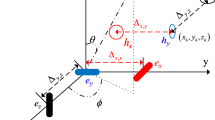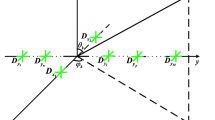Abstract
The radiation efficiency of short electric dipole and small magnetic loop is low. Therefore, the long electric dipole and large magnetic loop for direction of arrival (DOA) estimation are investigated in this study. A novel array composed of long electric dipole, large magnetic loop, or a hybrid long electric dipole and large magnetic loop is proposed. Then a corresponding algorithm based on ESPRIT is proposed to estimate the two-dimensional (2D) DOA. The proposed array has eight elements. The first four elements and other four elements construct the rotational invariant property. Then, the 2D direction cosine can be estimated accurately but with ambiguity. After that, the ambiguous value is instituted into the spatially spread vector sensor for spatial phase compensation. Then, the steering vector of the collocated orthogonal vector sensor is obtained to calculate a fake coarse DOA estimation. By comparing the above ambiguous fine estimation with the fake coarse estimation, the closest estimation is taken as the finally 2D DOA estimation. The computation of the proposed algorithm is small due to a lack of angle searching. Moreover, the long dipole has high radiation efficiency, and the spatially spread vector sensor has low mutual coupling. Simulation results demonstrate the effectiveness of the proposed algorithm.








Similar content being viewed by others
Availability of Data and Material
The data and material used to support the findings of this study are available through Dr. Zheng, email: zheng-gm@163.com.
References
Y. Hua, A pencil-MUSIC algorithm for finding two-dimensional angles and polarizations using crossed dipoles. IEEE Trans. Antennas Propag. 41(3), 370–376 (1993)
M. Hurtado, A. Nehorai, Performance analysis of passive low-grazing-angle source localization in maritime environments using vector sensors. IEEE Trans. Aerosp. Electron. Syst. 43(2), 780–789 (2007)
S. Khan, K.T. Wong, Electrically long dipoles in a crossed pair for closed-form estimation of an incident source’s polarization. IEEE Trans. Antennas Propag. 67(8), 5569–5581 (2018)
S. Khan, K.T. Wong, Y. Song, W.Y. Tam, Large circular loops in the estimation of an incident emitter’s direction-of-arrival or polarization. IEEE Trans. Antennas Propag. 66(6), 3046–3055 (2018)
B. Liu, B. Li, Y. Feng, G. Zheng et al., Vector-cross-product-based 2D-DOA and polarization estimation with “long” electric-dipole quint. IEEE Access 7, 27075–27085 (2019)
B. Li, W. Bai, Q. Zhang, G. Zheng et al., High accuracy and unambiguous 2D DOA estimation with a uniform planar array of long electric-dipoles. IEEE Access 6, 40559–40568 (2018)
J. Li, R.T. Compton, Angle and polarization estimation using ESPRIT with a polarization sensitive array. IEEE Trans. Antennas Propag. 39(9), 1376–1383 (1991)
F. Luo, X. Yuan, Enhanced “vector-cross-product” direction-finding using a constrained sparse triangular-array. EURASIP J. Adv. Signal Process. 2012, 115 (2012)
L.L. Monte, B. Elnour, D. Erricolo. Distributed 6D vector antennas design for direction of arrival application, in IEEE International Conference on Electromagnetics in Advanced Applications (IEEE Press, Torino, Italy, 2007), pp. 431–434
L.L. Monte, B. Elnour, D. Erricolo et al. Design and realization of a distributed vector sensor for polarization diversity applications, in IEEE International Waveform Diversity and Design Conference (IEEE Press, Pisa, Italy, 2007), pp. 358–361
L.L. Monte, B. Elnour, A. Rajagopalan et al. Circularly and linearly distributed narrowband vector antennas for direction of arrival applications, in North American Radio Science Conference (Ottawa, Ontario, Canada, 2007), pp. 22–26
A. Nehorai, E. Paldi, Vector-sensor array processing for electromagnetic source localization. IEEE Trans. Signal Process. 42(2), 376–398 (1994)
C.M.S See, A. Nehorai. Source localization with distributed electromagnetic component sensor array processing, in IEEE Seventh International Symposium on Signal Processing and Its Applications (IEEE Press, 2003), pp. 177–180
A.J. Weiss, B. Friedlander, Direction finding for diversely polarized signals using polynomial rooting. IEEE Trans. Signal Process. 41(5), 1893–1905 (1993)
K.T. Wong, Y. Song, C.J. Fulton, S. Khan, W.Y. Tam, Electrically “Long” Dipoles in a collocated/orthogonal triad—for direction finding and polarization estimation. IEEE Trans. Antennas Propag. 65(11), 6057–6067 (2017)
K.T. Wong, X. Yuan, “Vector cross-product direction-finding” with an electromagnetic vector-sensor of six orthogonally oriented but spatially noncollocating dipoles/loops. IEEE Trans. Signal Process. 59(1), 160–171 (2011)
K.T. Wong, M.D. Zoltowski, Closed-form direction-finding with arbitrarily spaced electromagnetic vector-sensors at unknown locations. IEEE Trans. Antennas Propag. 48(5), 671–681 (2000)
Y. Xu, Z. Liu, X. Gong, Polarization Sensitive Array Signal Processing (Beijing University of Technology Press, Beijing, 2013)
M. Yang, J. Ding, B. Chen et al., Coprime L-shaped array connected by a triangular spatially-spread electromagnetic vector sensor for two dimensional direction of arrival estimation. IET Radar Sonar Navig. 13(10), 1609–1615 (2019)
X. Yuan, K.T. Wong, K. Agrawal, Polarization estimation with a dipole-dipole pair, a dipole-loop pair, or a loop-loop pair of various orientations. IEEE Trans. Antennas Propag. 60(5), 2442–2452 (2012)
X. Yuan, K.T. Wong, Z. Xu et al., Various triads of collocated dipoles/loops, for direction finding & polarization estimation. IEEE Sens. J. 12(6), 1763–1771 (2012)
G. Zheng, Two-dimensional DOA estimation for polarization sensitive array consisted of spatially spread crossed-dipole. IEEE Sens. J. 18(12), 5014–5023 (2018)
G. Zheng, D. Zhang, BOMP-based angle estimation with polarimetric MIMO radar with spatially spread crossed-dipole. IET Signal Process. 12(1), 113–118 (2018)
Z. Zhuang, Z. Xu, S. Xiao et al., Polarization Sensitive Array Signal Processing (National Defense Industry Press, Beijing, 2005)
I. Ziskind, M. Wax, Maximum likelihood localization of diversely polarized sources by simulated annealing. IEEE Trans. Antennas Propag. 38(7), 1111–1114 (1990)
M.D. Zoltowski, K.T. Wong, ESPRIT-based 2D direction finding with a sparse array of electromagnetic vector-sensors. IEEE Trans. Signal Process. 48(8), 2195–2204 (2000)
M.D. Zoltowski, K.T. Wong, Closed-form eigenstructure-based direction finding using arbitrary but identical subarrays on a sparse uniform rectangular array grid. IEEE Trans. Signal Process. 48(8), 2205–2210 (2000)
Acknowledgements
We thank LetPub (www.letpub.com) for its linguistic assistance during the preparation of this manuscript.
Funding
This work was supported By the National Natural Science Foundation of China (No. 61971438, 61871395), the Young Talent Fund of University Association for Science and Technology in Shaanxi, China (No. 20180109) and the Natural Science Basic Research Plan in Shaanxi Province, China (No. 2019JM-155).
Author information
Authors and Affiliations
Contributions
GZ provided the idea of this study. GZ, YS, GH, and BL wrote this paper.
Corresponding author
Ethics declarations
Conflict of interest
The authors declare that they have no conflict of interests.
Additional information
Publisher's Note
Springer Nature remains neutral with regard to jurisdictional claims in published maps and institutional affiliations.
Rights and permissions
About this article
Cite this article
Song, Y., Hu, G., Zheng, G. et al. ESPRIT-Based DOA Estimation with Spatially Spread Long Dipoles and/or Large Loops. Circuits Syst Signal Process 39, 5568–5587 (2020). https://doi.org/10.1007/s00034-020-01420-y
Received:
Revised:
Accepted:
Published:
Issue Date:
DOI: https://doi.org/10.1007/s00034-020-01420-y




